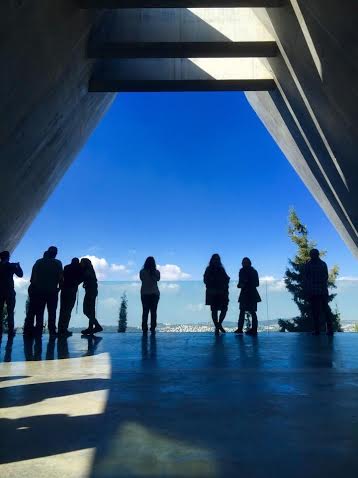
Yad Vashem
There is no way to write about all of the elements of today's visit to Yad Vashem. I could discuss the architecture, the use of carpeting and concrete, the individual displays, the children's memorial, the Path of the Righteous Gentiles, the range of emotions, the debriefing, etc. I chose here to focus on my thoughts during the second half of our tour of the main museum, starting with the displays of life in the concentration camps.
I stare at the projected video images rolling silently on the wall: short clips of emaciated bodies crouched in various positions of suffering. Their bodies captivate me. As a medical student, I take particular notice in people's shapes, structures, and movements. Consequently, the unnaturalness of the figures are particularly striking: the bugging eyes, the protruding collar bones, withered breasts, and deathly thin thighs. Bony knees protrude out of ragged clothing, creating a series of obscure angles on the screen. Over and over again, I look from in-turned feet to absent calves and up to skeletal thighs, my eyes tracing the disconcerting 45-degree angles of wasted legs. I wonder how such legs could walk, could even stand.
We continue on to the room that embodies the meaning of Yad Vashem, or, "a memorial and a name." I look around at the hundreds of books carrying the weight of millions of victims' names, wondering if my grandpa's family has been remembered in their pages. Photographs are featured in a massive circular display above our heads. Staring down at me, however, are not emaciated bodies, but people; people with plump faces, warm eyes and full lives. I no longer wonder how those angular legs could stand, but rather the places those legs had walked to before the war. What kinds of homes did those bugged eyes look upon in earlier years? To which children had those starved breasts previously given life?
At last, we walk toward the exit of the triangular prism through which we have just journeyed. As I take these steps towards the light outside, I think about the steps my grandfather took toward America after the war, and the steps he took, with millions of other Jews around the world, to rebuild a family, a home, and a Jewish identity. Outside, we take in a breathtaking sight of Jerusalem, the literal light at the end of the museum tunnel. In this moment, the city rests peacefully on its mound, and tall trees surround us. Framing this view are the 45-degree angles of a triangle, the building block of the Star of David.

